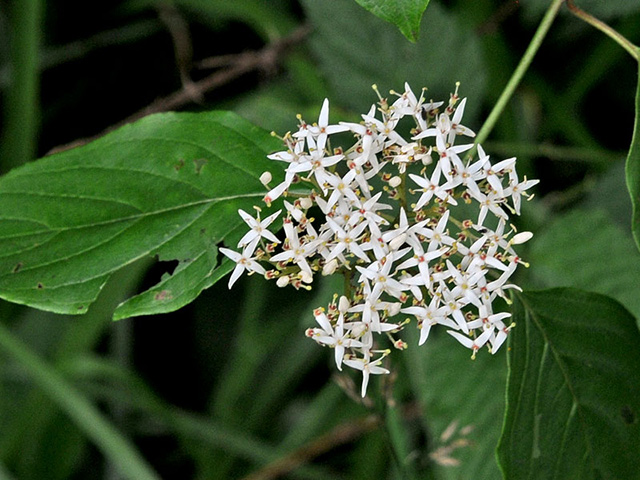Silky Dogwood
Cornus amomum
Dogwood family, Cornaceae
Silky Dogwood (Indigo) is a native North American shrub that can be found as far west as Missouri and Iowa, as far south as Florida, and as far north as Maine. Look for this large shrub in meadows and fields, on the banks of rivers, lakes, swamps and on the edges of wetlands where soil is moist and well-draining. Silky Dogwood can tolerate varying levels of shade, but cannot tolerate drought. When in the right environment, this hardy shrub can grow to 6-10 feet tall and wide, making it a great candidate for field and farmstead windbreaks and wildlife borders. The shrub will grow to be upright and rounded and may form roots when stems come into contact with the ground. This creates a thicket system, which can help with erosion control on streambanks.
An adolescent dogwood plant will display beautiful, bright red twigs covered in fine, silky white hairs. These young twigs have a distinctive dark brown pith (which can be seen when snapped open) and are covered in opposing, simple, dark green ovate leaves that have prominent, inward curving veins and are coated with fine, silky, white hairs on their undersides.
In the late spring or early summer, flat-topped clusters of small white flowers will appear and the Silky Dogwood will become a popular nectar pitstop for all sorts of local butterflies. Later in the summer, the flowers mature to white, berry-like drupes that slowly take on a lovely blue color when they fully mature in the fall. The fruit is quickly eaten up by game birds, and is an especially important source of food for migrating songbirds. In the winter, most leaves will drop off and twigs will take on a deeper color ranging from brown to purple, and even gray in older age.
Sources:
http://plants.usda.gov
http://www.abnativeplants.com
/index.cfm/fuseaction/plants.
plantdetail/plant_ID/412/index.
htm
http://gobotany.newengland
wild.org/species/swida/amomum
http://www.naturehills.com/
dogwood-silky
http://www.nrcs.usda.gov/
Internet/FSE_PLANTMATERIALS/
publications/mipmcrb12213.pdf |

